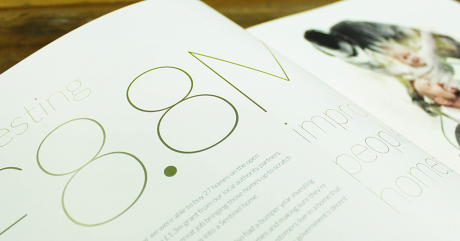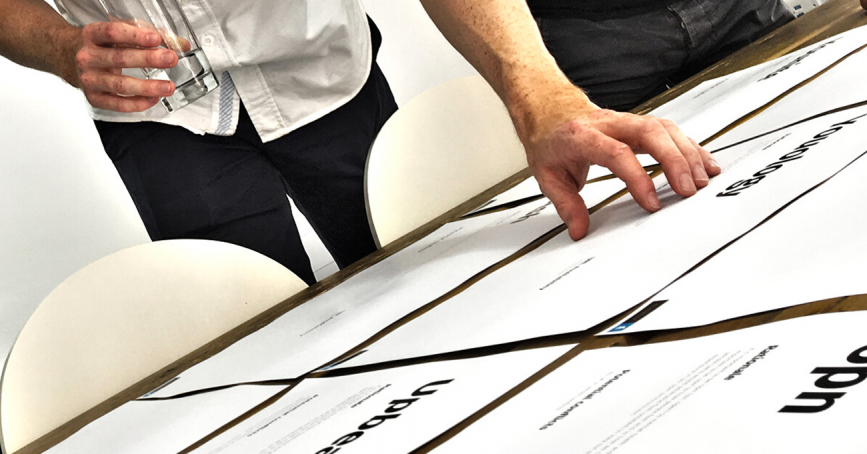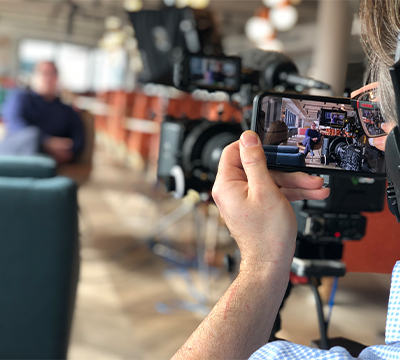
Insights Onboard with the rebrand?

The challenges of internal buy-in and how to overcome them.
Every now and then we embark on a branding project, either from the ground up or a re-brand, and for various reasons the project will peak and trough in terms of understanding, engagement, decision making and more.
It appears that however well prepared you try to be, whether you’re the agency or the client side project lead, curve balls tend to get thrown that highlight a lack of internal alignment.
We have experienced this at varying degrees over the years, but it’s occurred twice recently which has led me to think about this as a challenge, why it happens and what can be done to overcome it.
The common scenario
Brand work is never entered into lightly. Nor should it be. We often acknowledge that change can be challenging, particularly if you are a bigger company with established products or services, a reputation to uphold and a large and diverse workforce. But we also acknowledge and are great advocates of how brand can and should be the driving force behind your business. It should drive engagement, culture, solutions and innovation, as well as inspire your marketing and communications activity.
So why can brand cause so much internal division and debate?
Well, picture this scene. Usually there is a brand champion (or champions) in the business that come to a conclusion that the brand does not necessarily fit the business or the business has outgrown the old brand and it needs updating to reflect the current business position and aspirations for the future. ‘Said’ brand champion speaks to various members of the business to gather initial opinions before engaging with an agency or agencies to start the discussion about how to tackle the challenge. Inevitably brand champions tend to be involved with the marketing because they see and understand the value a brand strategy and visual identity can do to achieve the outcomes they are tasked with and measured by.
It’s safe to assume that conversations or chemistry meetings get underway, proposals are requested and submitted and in some cases, initial phases of work are commissioned. Excitement, engagement and satisfaction that something is happening within those involved gets heightened and the agency are buzzing because they can see the value they can bring and the difference they can make to ‘business X’ (as well as the amazing new creative work for the team, the shiny new case study for the portfolio and maybe even an award or two for everybody to be proud of).
Then comes the bombshell.
The Head of X in department Y that plays golf with the MD and has a voice at the ‘big table’ finds out about this ‘brand stuff’ and puts the brakes on the whole affair, launching an internal investigation into who, why, when and what. The nightmare scenario for everyone kicks in. And why? Because he/she wasn’t aware of the project, why it was important or needed and most commonly, wasn’t asked to be involved.
Being an influencer, the Head of X talks to his/her fellow influencers and before you know it, everything is put on ice while the internal investigation takes place.
At this stage, you can generally guarantee opinions will be difficult to change and the do we? don’t we? debate will no longer focus around business need and value, but time, money and resource.
Not that those things are not core considerations and components of any brand project, they undoubtedly are, but if they are considered and agreed at the right time and with the right awareness and buy-in, the discussions around them become far easier and less contentious.
So, where does all this leave the brand ambassador that needs to somehow kick-start the brand, marketing and communications, as well as engage the internal audiences and deliver business outcomes in time for their next performance review?
Well, in a nutshell, in ‘no brand land’. It’s like no mans land, just without the uniform. Unfortunately, the mud and bullets are still flying.
The typical challenges of getting unanimous internal buy-in
The example above is just one scenario where internal buy-in for something that is genuinely important and valuable for any business, can go awry.
I have touched on a few points already, but here are the most common challenges I have experienced over the years.
- A knowledge gap in what brand actually is and the value it can offer a business
- A lack of defined business/brand objectives – the “why are we doing this again?”
- A lack of cohesion on desired outcome – is it strategy and visual identity or one or the other? what does the business want/need to achieve?
- A lack of understanding and agreement on the role of brand within the business and who’s responsibility it is to drive it
- A lack of evidence to suggest a re-brand is required
- A lack of budget allocation
- A lack of awareness and communication that the project needs to or ‘is’ happening
- An unbalanced and/or non-inclusive project steering team
- Divisions within the business – some for, some against a rebrand and/or reposition
- A bad historic experience doing a similar piece of work
- A belief that it’s best done in-house
- A stakeholder has a preferred partner that is not involved or personal reasons for refusing to buy-in
How to achieve internal buy-in
There’s no magic formula unfortunately. It’s different for every business and the people within it. It’s often a call made on gut feeling and how well you know the internal workings.
My first piece of advice is this. And if you’re a seasoned marketer, you’ll know this already, but if you’re new to a business, don’t try and kick-start a re-brand in the first 6 months of your role unless you have been specifically told to (and if you have, weigh up the ‘why’ you’ve been asked to do it before you start – it may be a personal whim). Diving in head first leaves you at risk of being labelled as disruptive and lacking the necessary knowledge and ’history’ required to truly know whether it’s a business benefit and a genuine requirement… or not. They may even think you’re simply trying to justify your existence. This is a fairly extreme perspective, but it’s a situation I’ve experienced before.
Brand in its simplest form is all about trust. Think about the brands that you are loyal to. Can you picture them? Good. Now consider the reasons why? Yep, you got it. It’s because you trust in what they deliver and that trust ensures your loyalty. You like being in their gang. You WANT to be in their gang.
Internal buy-in is essentially the same. Gain their trust first, get them to buy-in to you personally and what you’re there to do, prove your worth with some quick wins, then go in for the biggy!
So let’s assume you’ve got the grounds right personally. What are the steps, and in what order should you do them to achieve that all important buy in?
Firstly, step back and think “How do I get collective buy-in to my ambition for what I want the brand to be”. The following steps may be bang-on, but you may also need to ‘move and groove’ in a way that you know works for your business. After all, they are all different.
Insight and evidence
Justifying the reasons why a re-brand is necessary is difficult if its purely subjective and circumstantial. As part of your business case for the project, undertake audience insight and generate evidence that supports your proposal. Gather insight and opinion from customers and colleagues, test your brand score and measure perceptions in the market. Use surveys and polls to create both qualitative and quantitative data. The more you have up your sleeve, the harder it is for anyone to argue with the reasons for your proposal.
Reference external brand statistics too. Prove to people how brand plays a role in the growth of a business. As an example, a 2017 McKinsey & Company study revealed that companies with a clear brand narrative perform 20% better than companies with a weak narrative. Also, decision-makers are 10% more likely to consider solutions from brands they understand and feel connected to. External proof points will only add value and credibility to your cause.
Objectives – business and brand
Clearly define what the re-brand is going to achieve for the business and what the business can do to support the brand. A brand strategy is not just marketing fluff, so try and justify the role it is going to play ‘for’ the business and ‘in’ business. Come at it from different perspectives such as sales, growth, reputation, staff engagement, loyalty and retention etc. The more perspectives covered, the easier it is to justify.
Business case
Create a business case that explains the what, why, how and when. And use your insight and evidence to support your proposal. Buy-in is far easier when you can explain all of the above and relate it to business performance, brand value and return on investment.
Awareness, communication and engagement
Ensuring you have the support and engagement of the right people in the right places is key. You can’t run a brand project like a democracy, that’s too many cooks, but you will need the buy-in of decision makers. They will also need to fully understand why you believe it is necessary. Take your business case to your line manager and discuss it with them first and agree the next line of engagement, this could be direct to the CEO… or not… but you can agree a plan of key people/teams to engage with and involve. Be sure not to assume certain people/teams are not relevant. An advocate in each part of the business is essential to ensuring the value of the project is distilled down through the business. Also consider how you are going to involve them so they feel like they are contributing effectively and they have ownership of whatever is created. Lastly, manage communications. Create a platform for continued comms so everyone is in the know. This may come after the project is agreed and ‘live’, but it’s still vital so no-one gets left out of the communication loop.
Education
Don’t assume that everyone knows what brand is and what it means for a business. Explain the details of and the differences between brand strategy and brand identity. Explain how it differs from marketing strategy for those that assume one is simply the other. Use examples where possible to help stakeholders understand and use those examples to demonstrate how a business has changed for the better as a result of the brand journey they have gone on. Maybe give them points of contact within other businesses that they can speak to that will advocate the brand journey and outcomes.
Brand Steering Group
This ties in with the awareness, communication and engagement section and may well be something that is created after the project gets the necessary green light to go ahead. But this doesn’t stop you planning the group of stakeholders and decision makers that you would like (and need) to be part of the journey you are going to go on. Involve different teams/people and ensure everyone that needs to be is either in the group or part of the communication chain. Be sure to get a good cross section of influence, from marketing to sales to HR and beyond. Identify who you need to help make the right decisions and who you need to ensure the right influence is around the table. It’s a careful balance, but played right, it can work to your advantage and help you achieve your goals quicker and easier.
Budget definition
The B-word is inevitable when it comes to a re-brand, along with the next section which is process and “what are we actually going to get for our money”. From an agency perspective, a re-brand can sometimes be difficult to accurately quote up front as there can be unknowns at early stages that influence time and resource later down the line. Sometimes a complete strategic reposition is not necessary. Sometimes it is. Giving internal stakeholders an idea of budget, process and outcome helps them understand what’s happening and where the value lies in the investment.
Process and outcomes
I’ve touched on this already, but explain what the journey looks like and what the project outcomes are going to be. This, again, will help stakeholders understand where the value lies. If an agency can’t really explain what you’ll get from your investment, then press them harder or go elsewhere. They may not have all the answers up front, but they should be able to give you enough explanation (with examples) that will help educate and inspire your internal audiences.
Partners and associated costs
Do your homework and identify partner agencies that can deliver what you believe you need. A conversation with an agency to see if there’s chemistry costs nothing and is important. If you are going to embark on this journey with your stakeholders, you need to feel comfortable and confident with the team you work with. There needs to be rapport and understanding, as well as a comfort zone that they have the tools and experience to deliver what you need. Once you have identified the right partners, and it’s best to identify a few, tell your stakeholders who you have approached, why you think they are a good fit, what their associated costs are and who your preference is to work with. This proves you’ve done your due diligence and you value the investment you are asking the company to make.
Also, don’t be afraid to ask agencies to provide examples of their previous brand work, including references. It’s good to find out from the horse’s mouth what they are like and whether they ‘cut the mustard’!
Finally, you don’t have to put all your eggs in one basket. Work with specialists, not generalists. Don’t be afraid of bringing in a group of agencies that can work together to deliver you, the client, the best outcome. Good agencies will not be afraid of collaboration that goes beyond the standard client/agency relationship in order to deliver the best outcome. Sometimes splitting strategy, creative and tone of voice (as examples) is the right thing to do.
Timeline
Another common question is “how long will this take?”. Cards on the table, brand projects are rarely easy, straightforward or quick, but approached in the right way, they can be strategic, enjoyable and extremely enlightening. So, get an idea of a predicted timeline from your preferred partner or partners. This will help people internally understand what they are letting themselves in for, what level of time investment they will need to make and when they will get the outcome you all want.
In summary
Change is challenging, no matter what change is taking place. A brand development project, either ground up or a re-brand should always be an opportunity to engage and invigorate a business rather than throw it into disarray.
It can sometimes be a long journey, sometimes not, but the value output and the strategic direction it gives a business should form a cultural glue, activated through people, growth, revenue and reputation.
The importance of getting the right internal advocates and buy-in should not be underestimated. The scenarios and steps I have outlined in this article are examples and guidance, but every business is different and unique. Take time to understand and evaluate the best approach to achieve the vision and outcome you desire for the business. Justified and approached in the right way, with a considered business case to support the project, you’ll soon find yourself in a position of strength.
If you need help to justify a branding project and would like a partner that will help you manage the internal on-boarding process (as well as the strategic and creative delivery!) then let’s start a conversation.
That brand you need may not be as challenging to achieve as you think.
Share insight
Let's talk
- Call us +44 (0) 1256 334567
If you would like to find out more about how we can help you connect strategically, creatively or digitally, then call us or get in touch. We’d love to hear from you.

















